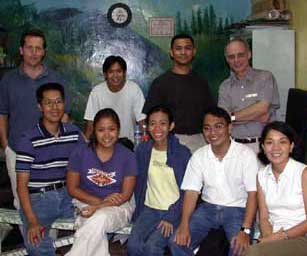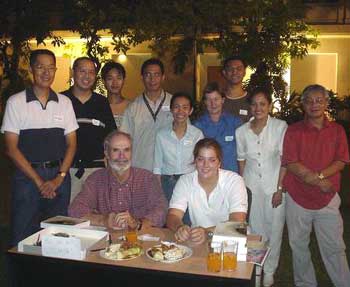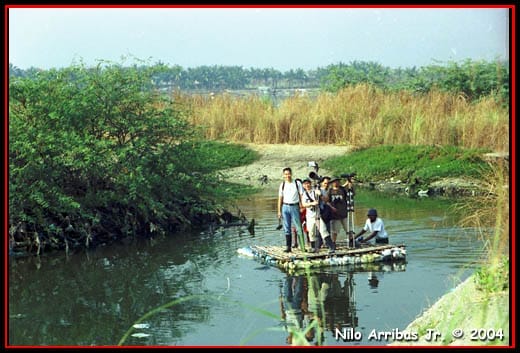
Club Background
The Wild Bird Club of the Philippines was established in July 2003 to promote bird watching as a hobby and the responsible enjoyment of nature.
A CLUB IS FLEDGED
The events culminating in the creation of the Wild Bird Club of the Philippines started on 9 January 2003 with the launch by a handful of Metro Manila-based amateur weekend birdwatchers of Birdwatch Philippines, an internet-based community for sharing information, observations and planning joint activities.
Like a fledgling taking its first flight, e-group members enthusiastically explored potential bird sites, eagerly added to the growing bird list and recruited new members along the way. In a short time, the Birdwatch Philippines e-group attracted a lively mix of correspondents, including professional scientists, amateur naturalists, students and outdoor enthusiasts. Its activities also attracted attention from leading newspapers and respected television programs.
By June, a survey undertaken among e-group correspondents resulted strongly in favor of the establishment of a formal society.

Front row L-R: Mike Lu, Kitty Arce, Lala Espanola, Ned Liuag, Tina Alejandro.
Back row L-R: James McCarthy, Drew Galano, Jon Villasper, Arne Jensen.
An interim executive committee was organized to foresee the day-to-day operations of the club with Mike Lu (President), Ned Liuag (Vice-President), Kitty Arce (Secretary), James McCarthy (Treasurer), & Jon Villasper. Other co-founders of the club are Tina Alejandro, Mads Bajarias Jr., Ricky de Castro, Lala Espanola, Lu-Ann Fuentes, Arne Jensen.
A VIBRANT YEAR
The first year proved a busy time for the Club. WBCP made an initial investment consisting of 10 pairs of 8 x 40 binoculars, which were immediately put to use during monthly guided bird walks. Later in the year, a Bushnell spotting scope was added to the inventory, while another one was donated by Canadian birder Todd Pepper, adding the capability to locate and accurately identify feathered subjects to Club members.
The weekend bird walks proved popular. The Club organized four trips to the American Cemetery, the Libingan ng mga Bayani, Tambo mudflats, and along Coastal Road in Metro Manila for beginning and first-time birders. These activities were organized for the public and free of charge, except for the minimal binocular rental fee. Because of public interest in the bird walks and its usefulness as a medium for promoting the hobby and recruitment, the Club continues to organize one every month. To date, we are the only organization that regularly offers this activity in the country.
Thirteen Club trips for members were initiated for members within Metro Manila, including special permit areas like the abandoned Nayong Pilipino park beside the airport and the La Mesa Dam watershed in Quezon City, and day trips to Mount Makiling in Laguna, Mt. Palay-Palay in Cavite and Candaba Marsh in Pampanga.
The Club was also invited to conduct guided birdwalks for different groups – Environment Management students from De La Salle University in Manila, during the Alternative Classroom week each for the state-run University of the Philippines – Diliman and Ateneo de Manila University, both in Quezon City, and staff from the Haribon Foundation. The Club also ssisted in the annual Candaba Marshlands birdwatching trip that drew 70 first-time birdwatchers.
In addition to this, WBCP gave a presentation on birdwatching to the members of the Federation of Philippine Photographers Foundation and guided photography enthusiasts to document urban green areas including the Arroceros Forest Park in Manila.
Club members were present to welcome Dr. Robert Kennedy, author of the comprehensive Guide to the Birds of the Philippines, during the book launch at the Museum of the Filipino People. With 13 members in attendance on a weekday, The Wild Bird Club of the Philippines was easily the largest contingent among the environmental and conservation organizations.

Seated: Dr Bob Kennedy and daughter
Standing L-R: Mike Lu, Sean Co, Mark Villa, Nilo Arribas, Lala Espanola, Genevieve Broad, Jon Villasper and museum personnel.
As part of the camaraderie among birdwatchers, Club members extended assistance to birders visiting from abroad – Todd Pepper of Canada, Ivor Lee of Singapore, Carlos Pijoan of USA and Anders Forsberg of Sweden. This practice is being continued to this date, and the Club invites birdwatching hobbyists, scientists and conservationists to get in touch with us when they are in the country.
BUILDING OUR RECORDS
As early as 2002, the individuals who were brought together in the Birdwatch Philippines e-group, the Club’s precursor, started compiling records for Metro Manila and areas outside the capital region.
Among the first initiatives undertaken by the interim executive committee was the establishment of the Philippine Records and Rarities Committee to ensure reports conform to internationally accepted standards and scientific procedures, believing that birdwatchers can and should contribute to the scientific record. The Committee included ornithologist Arne Jensen and long-time birdwatcher James McCarthy.
The bird lists draw from data gathered by individual members, nature conservation groups and international sources. The bird list for Metro Manila, to our knowledge is the first one in existence. The Country bird list contains data sent in by Club members on trips outside Metro Manila and is supplemented by records from birdwatchers visiting from abroad, and the Haribon Foundation.
These activities did not go unnoticed by policy makers. The Manila Bay Environment Management Project, an arm of the Department of Environment and Natural Resources requested the Club to present its findings concerning bird life along the coast of Parañaque. This resulted in an agreement to cooperate in spearheading the Asian Waterbird Census in the section of Manila Bay within the National Capital Region in January 2004.
SPOTLIGHT ON BIRDWATCHING
Birdwatching captured media attention in 2003. Investigative reporter Howie Severino did a segment for GMA-7’s late evening news program SAKSI on birdwatching and the breeding grounds of the Oriental Pratincole and Black-Crowned Night Heron that the Club discovered in the South Reclamation Area. The PROBE TEAM, internationally-acclaimed telemagazine produced the episode “Mga Tagong Ibon ng Maynila” [The Hidden Birds of Manila], presented by artist-birdwatcher Robert Alejandro.
The Philippine Center for Investigative Journalism took note of Howie Severino’s report and published it as “Birdwatchers in the City” in the September 2003 issue of the quarterly I-Magazine. Birds and birdwatching received an interesting review in reporter Maida Pinedas “Sightings Beyond the Maya” which appeared in StarWeek magazine, the Sunday supplement of The Philippine STAR.

TOWARDS THE FUTURE
The Philippines is a mecca for birdwatchers and scientists. And while the Club is not yet in the position to undertake projects that are vital to the conservation of habitats and bird species, the Club’s aim in the medium-term is to promote birdwatching not as an end in itself but as the means to influence public opinion.
In the few months that Club members have been birding around Metro Manila, they have seen rapid disturbance in bird habitats. The Club recognizes that commercial development will have to take place sooner or later, but it is in the common interest to temper this development with environmental planning and protection and the maintenance of public free spaces and green areas.
As a self-financing, membership-driven organization, the WBCP is in a best position to educate by example and to inspire in others the responsible enjoyment of nature. But we cannot do it alone. So it is with sincerity that the Club extends its offer to cooperate and share information with scientists, educators, birdwatchers and nature conservation organizations here and abroad.
